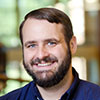This article is more than 5 years old.
This being my first “real” NCLA (I presented once in 2013, but didn’t stick around), I wasn’t sure what to expect. As others have mentioned, though, I found that this conference was a great opportunity to reconnect with friends and colleagues I don’t get to see often enough, especially those in the public library world. That was the best part. But coming in a close second was getting to hear from folks who are doing interesting things with instructional technology at different types of institutions–especially those at community colleges–who typically serve much more traditional “distance” education programs than what we do here at Wake Forest. I was also excited to be installed as the Secretary/Treasurer of the newly-formed Distance Learning Section.
I attended some great sessions, including one from Amy Harris Houk at UNCG on active learning strategies in online courses (lots of good engagement from the audience led me to rediscover H5P, a tool for creating interactive HTML learning objects) and a session from the good folks at Central Carolina Community College, who shared their process for designing a comprehensive plagiarism tutorial with Google Sites.
Maybe my favorite session was on the re-making of FCPL’s Central Library downtown. Elizabeth Skinner (FCPL), Damon Sanders-Pratt (Forsyth Co.), and Jesse Green (RATIO Architects) presented the impressive process behind the library’s transformation. I was especially impressed by the amount of input–and even leadership–the project’s various stakeholders had in designing the new space. RATIO’s LiveDesign process, which involved every single library staff member at some point, really took into consideration staff and community needs and expectations. They carefully studied the old building’s shortcomings (which were many), considered the site’s restrictions and affordances (views, light, lawn space, neighbors), paid close attention to sight lines for wayfinding, carefully ensured access to daylight throughout the entire building, and placed various services and access points strategically throughout the new space to ensure sensible workflows and traffic patterns. The results speak for themselves. It’s amazing what’s possible with $28 million and a (mostly) blank slate!

2 Comments on ‘Kyle at NCLA 2017’
Yes, absolutely. It’s amazing what you can do with a mostly blank slate!
I figured you were having a good conference, I kept having Kyle sightings all over the conference!